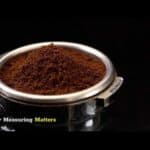In this hand carved wooden coffee scoop tutorial, I show you how to carve a walnut coffee scoop. The past few months, I’ve become fascinated with carving and making wooden spoons and scoops. In this blog, we also have an article about how big is coffee scoop that you might want to see.
Except for the jigsaw, I haven’t used any power tools in this tutorial. You and your hands become more intimate with the wood when carving. Through this approach, I’ve learned a lot about wood and its different properties. In the end, this is about fine-tuning my woodworking skills, and I hope it does the same for you.
Carving spoons or scoops is a relaxing and enjoyable hobby. Only a few tools are needed, and you don’t need a big shop to do it. My latest spoon project might keep me sitting in my kitchen chair some nights. I might also be sitting on the porch with a box fan and a glass of ice tea in an Adirondack chair. Yes, I’ll sweep up the shavings later. I need to remind the wife. Nevertheless, she loves new spoons for stirring soup when I show them to her. The tutorial should be enjoyable, so let me know what you think!
How To Make Wooden Coffee Scoop
Step 1 – Wood Selection
Make sure the hardwoods you use have a closed grain. In the kitchen, spoons or scoops are essential tools. To make them splinter-proof, making them durable, and somewhat water-resistant is important. It is also important that the wood you use for carving does not readily split. You can accomplish these goals by using closed-grain hardwoods. The following are examples of closed-grain hardwoods: maple, birch, cherry, hickory.
Can some woods be toxic? That’s a good question. Find out more about the toxicity of different woods by visiting this website. To be honest, I’ve read several articles and forum posts about this topic, but I’m still confused. Personally, I don’t believe wooden spoons are exposed to food for a long enough period of time to impart high levels of toxins (assuming you don’t leave them in food). However, I am not an expert, so use your best judgement and do your own research.
I chose walnut as a material for the tutorial. Although technically open-grain, it’s a tough material that I enjoy. It carves well and can be used as a coffee scoop. As a general rule, when selecting your board, make sure the grain runs straight both on the face and the side. You will be able to get the strongest spoon / scoop this way.
Step 2 – Trace Scoop Design On To Wood
Somewhere on the internet, I found a picture of a coffee scoop, and I printed it out. As a template, I traced it onto some card stock. Once I had the template, I traced around it with a pencil on to the walnut.
Step 3 – Cut the Scoop Body Out
Several options are available to you here. Before I cut out the entire coffee scoop body, I usually carve out the scoop bowl area. The board can then be clamped and you can work with both hands while goinguge.
I’m going to cut out the scoop body first for this tutorial.
Make scoops and spoons with only a jig saw, which is the only power tool you will need. Ensure that your blades are curve-cut. On the package, it may say “scroll.”. Wooden curves will be easier to cut with these blades. In general, the more teeth per inch on the blade, the finer the cut.
This tutorial takes you through the basics of jigsaw puzzles if you are new to them.
Step 4 – Carve Out Scoop Bowl Area
For securing the wood to my bench top, I used a c-clamp. Start by removing most of the bowl material with one of the gouges. The gouge should be used to make shallow, shearing cuts, always working downhill (against the grain) and from the outside (marked line) toward the center. Starting out, you can go either with the grain or across the grain. My practice of moving across the grain gets finer and finer as I refine it.
It is best to use a #7/10mm or #7/20mm gouge (see top photo, 1st tool on left) to hog out most of the scoop. Using a 10mm gouge, I carved out the area of the bowl in the next photo down. Gouges with this profile are perfect for spoons. The end goal is to align the profile of your scoop (bowl) with the profile of your carving tool. By the way, the first number (#7) is called the sweep, and it refers to the gouge’s profile/shape. The second number (#10 or #20) indicates the width of the gouge.
With the gouges, you could do all of the scoop (bowl) carving, but I also like to occasionally use the hook knife (see top photo, third tool to the right). On both sides, this knife is curved and has a bevel. Knife strokes are similar to ice cream scoops. As you scoop wood out of the scoop, begin at the rim and sweep downwards.
During this process, you must support the bevel of the knife. Push-cutting is also possible, as long as you get the correct angle and secure a handle on the scoop. This knife I like to use after I’ve done most of the rough work with the gouges. You can then refine the profile and smooth the surface more with the hook knife. I have used the hook knife to clean out the scoop area in the last photo.
Make sure you use controlled strokes and movements to handle these knives, because they are extremely sharp. Learn where the blade will be heading after a cut, and ensure that your cut is straight. Make sure your thumb or other fleshy parts are not in the way. For now, you may want to wear gloves or thumb guards until you get the hang of it. When you use a glove, make sure that it will grip the gouges and knives well and will not slip. Otherwise, take your chances, but it’s good to have some bandaids on hand in case of minor cuts. You should probably practice techniques on scrap wood first.
Step 5 Carve the Rest of the Scoop
I use my Mora 120 straight blade knife to carve the rest of the scoop. The blade of any straight-bladed knife (suited to carving) will do, however. Obviously, you don’t want to use a big, cumbersome hunting knife.
When I wanted to remove a lot of material faster, I used the scissor cut shown above, keeping my hands and arms close to my stomach with the blade pointing away from my torso.
Once a lot of waste material has been removed, I like to use short, controlled pull cuts around the bottom, rim, and handle. I’ll use the push cut to make even more controlled cuts. Ensure that your thumb or other fingers do not come into contact with the blade.
When cutting with the grain, keep the blade at a shallow angle and use light, shearing strokes. Avoid cutting too far into the grain or tearing it. The last thing anyone wants is to get splinters in their mouths from their wooden utensils. If you feel that you have dug into the wood too deeply or are about to tear some grain out, reverse the blade and cut from the opposite direction until your surface is smooth. It takes some practice, but you’ll get the hang of it.
After I got the scoop to the final shape I wanted (see last two photos above), it was time to sand.
Step 6 – Sand the Scoop
In the case of the coffee scoop, it may not be necessary to sand the surface smooth. After all, it’s just a scoop of coffee and not meant to go into someone’s mouth. It’s also nice to have a chip carved finish, which also looks fantastic. Because I prefer a smooth finish, I hand sanded mine.
Start with 80 grit sandpaper, then move on to 120, 220, 400, and 500 grit. When sanding, try to keep the grain as straight as possible. For most of the work of removing peaks and valleys, 80 grit will be sufficient. With carving tools, it is obvious that the better job you do, the higher grit can be used as a starting point.
It is my preference to use Micro Mesh cloths between 1500 grit and 8000 grit. Below is a photo of the middle of the picture.
The Micro Mesh might be overkill, but it leaves a smooth, silky finish on the wood. Since I only use mineral oil as a finish, I like to take this extra step.
Step 7 – Finish the Scoop
On my spoons and scoops, I like to use a food-safe mineral oil. Other food-safe finishes are available that are food safe when properly cured. Additionally, they may give the wood grain some extra strength. The directions on the container should be followed.
After applying generous amounts of mineral oil to the scoop, I let it set over night, then I apply another coat and let it set for 24 hours. Remove excess with a damp cloth.
Following the application of mineral oil, some people like to apply butcher block conditioner (see photo above). Follow the instructions on the back of the container. The scoop can be buffed after the conditioner has been allowed to sit. Rather than using a conditioner, I applied mineral oil for this scoop.
Thanks for taking the time to watch this tutorial! Please consider subscribing if you’d like to receive more tutorials in your inbox. Please sign up using the form below. My free tool checklist will be sent to you if you sign up for my newsletter. You will also receive my monthly newsletter. Looking for best coffee scoop recommendation? we have a list you can check.
Was this helpful?
Hi there! I’m a food enthusiast and journalist, and I have a real passion for food that goes beyond the kitchen. I love my dream job and I’m lucky enough to be able to share my knowledge with readers of several large media outlets. My specialty is writing engaging food-related content, and I take pride in being able to connect with my audience. I’m known for my creativity in the kitchen, and I’m confident that I can be the perfect guide for anyone looking to take their culinary journey to the next level.









